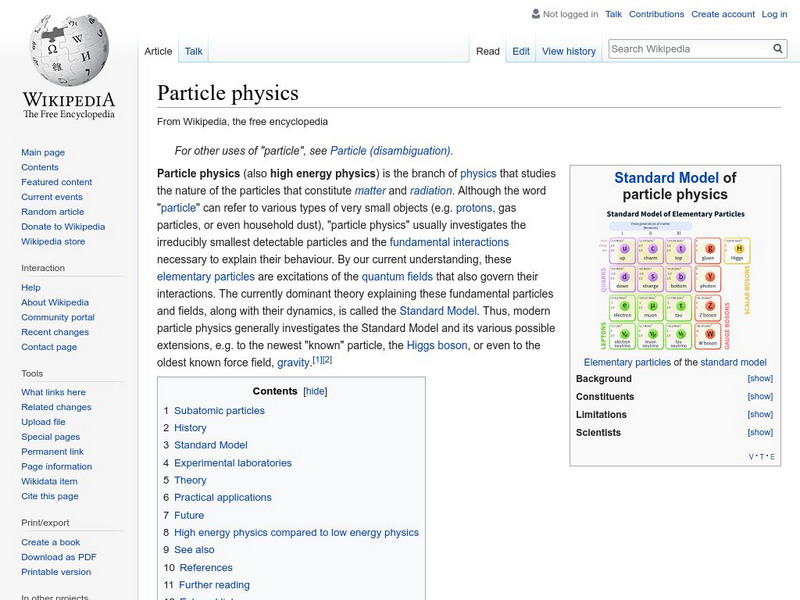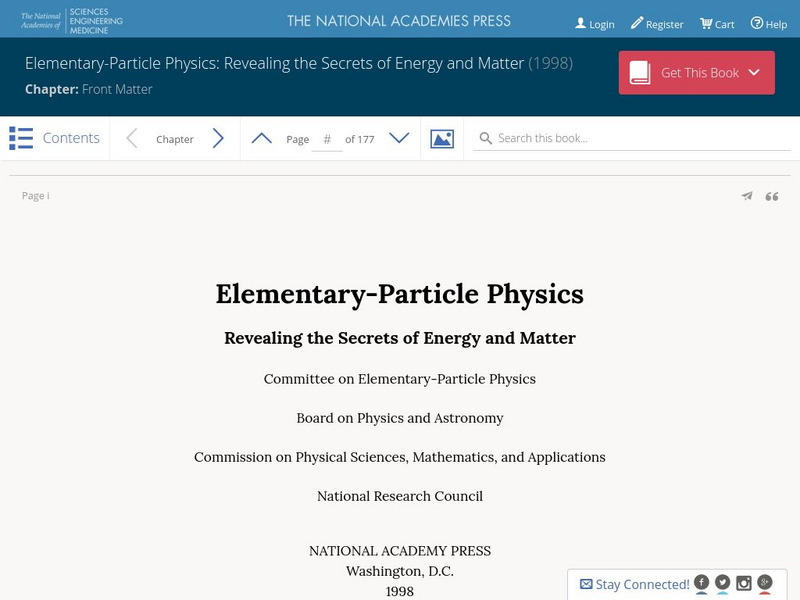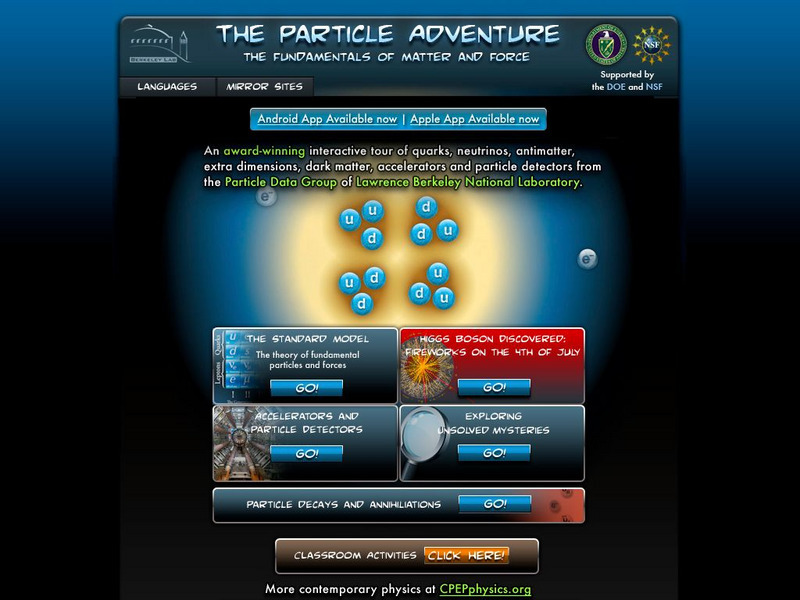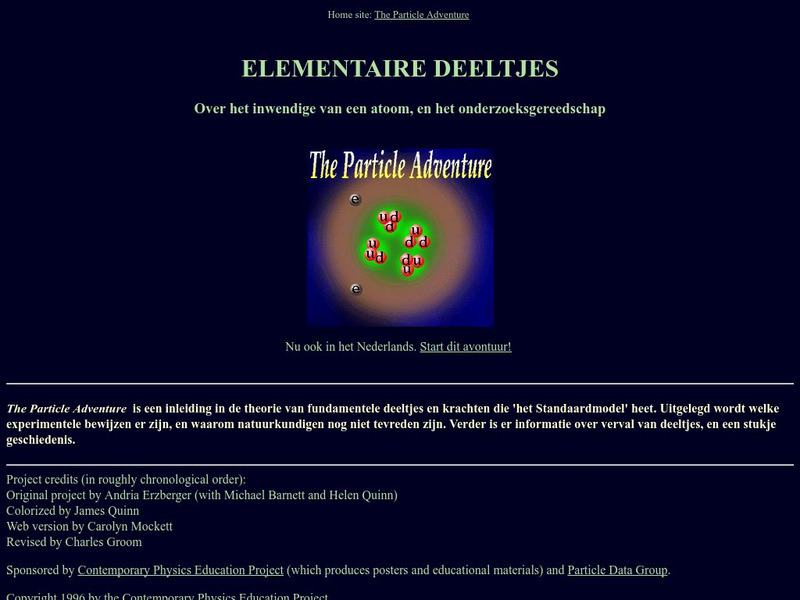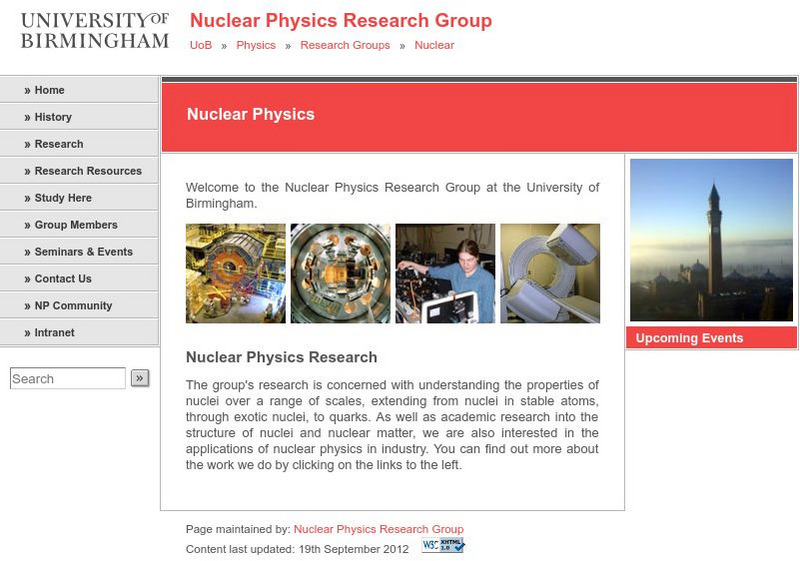Other
Ippog: Hands on Particle Physics
Looking for more insight into particle physics? Search among several general particle physics resources. Or locate a specific particle physics institute in your area of the world.
Other
Interactions Collaboration: Particle Physics Glossary
A comprehensive glossary of terms and acronyms used in particle physics.
Other
Particle Physics at Discovery's Horizon
Explore the Large Hadron Collider (LHC) and how the U.S. Department of Energy and National Science Foundation have collaborated with this huge project and related experiments. You can find facts about the LHC, browse a bank of high...
Other
Lancaster University: Particle Physics Package
A collection of experiments, projects, and articles that will help students understand particle collision and mass, kinetic energy, magnetic field, the Large Hadron Collider, and detection of the Higgs particle.
Wikimedia
Wikipedia: Particle Physics
An in-depth encyclopedia article on particle physics. Discusses what encompasses the study of particle physics, gives a history of particle physics, briefly describes the Standard Model of particle physics, discusses the dispute that...
Other
National Research Council: Elementary Particle Physics
The Committee on Elementary-Particle Physics, part of the U.S. National Research Council, presents this massive report on particle physics. It's a definitive document. Surprisingly readable, totally detailed. Start with the Table of...
Other
Lancaster University: Particle Physics Package: Higgs
A look at where the Higgs boson exists within the Standard Model of particle physics. Explains forces in the Model (electromagnetism, strong nuclear force, and weak nuclear force) and offers thoughts on how the Higgs particle might be...
Lawrence Berkeley National Laboratory
Berkeley Lab: The Particle Adventure
Visit this site for an interactive tour of the atom and all aspects of particle physics. View the animations available with almost every description on this site. A great place for the fundamentals of particles and forces including a...
Symmetry Magazine
Symmetry Magazine: Explain It in 60 Seconds: Virtual Particles
Virtual particles, described here, are particles that appear and disappear so rapidly they can be detected only by their effect on other particles. "Explain It In 60 Seconds" is an article series that aims to summarize in a few...
Symmetry Magazine
Symmetry Magazine: Explain It in 60 Seconds: Particle Event
Particle events, described in this article, are events that can be observed with a particle detector. "Explain It In 60 Seconds" is an article series that aims to summarize in a few paragraphs the meaning of different concepts in...
Symmetry Magazine
Symmetry Magazine: Explain It in 60 Seconds: Rare Particle Decays
Rare particle decays, described here, are events that could lead to insights into the unknown processes of the universe. Scientists hope to learn more about them through research with particle accelerators. "Explain It In 60 Seconds" is...
Symmetry Magazine
Symmetry Magazine: Explain It in 60 Seconds: Acceleration of Particles
The process of particle acceleration is described. "Explain It In 60 Seconds" is an article series that aims to summarize in a few paragraphs the meaning of different concepts in particle physics.
Symmetry Magazine
Symmetry Magazine: Explain It in 60 Seconds: Particle Accelerators
Particle accelerators and what how they are used in research are explained briefly but succinctly here. "Explain It In 60 Seconds" is an article series that aims to summarize in a few paragraphs the meaning of different concepts in...
PBS
Pbs Learning Media: String Theory: Elementary Particles
This interactive activity from the NOVA Web site looks at the fundamental forces and particles that make up all matter. A thorough description of each elementary particle is provided including their mass, charge, spin, strength, and range.
Concord Consortium
Concord Consortium: Molecular Workbench Showcase: Physics, Quantum Physics
A collection of simulations to show the important topics of quantum physics.
University of Colorado
University of Colorado: Ph Et Interactive Simulations: Self Driven Particle Model
An interactive tutorial that introduces the particle model incrementally and depicts the computation of the order parameter, critical parameter, and critical exponent.
Science Struck
Science Struck: What Is the Higgs Boson Particle?
A detailed explanation of the Higgs Boson particle and the science of particle physics. Discusses the history of the search for this particle, the ongoing research with the Large Hadron Collider at CERN in Europe, and what is known so...
Lawrence Berkeley National Laboratory
Berkeley Lab: The Particle Adventure: Leptons
This particle physics tutorial discusses the different types of leptons: the electron, tau lepton, muon lepton, and neutrinos.
Other
Particle Adventure Dutch Version
Dutch version of the well-known "Particle Adventure" physics website that teaches students about atoms, mass, particle physics, and quantum physics. The site discusses theories related to physics and provides other links related to the...
American Association of Physics Teachers
Com Padre Digital Library: Open Source Physics: Circular Well Model
This downloadable java simulation models the 2D energy eigenstates of a particle trapped in a very deep two-dimensional circular well.
Other
University of Birmingham: The Nuclear Physics Group
This is the website of the Nuclear Physics Group at the University of Birmingham. There is information on research, degrees, seminars, etc.
Other
Particles, Special Relativity and Quantum Mechanics
Quantum physics, despite its inherent weirdness, is thus far the best model physicists have for explaining the universe. This site gives a great overview of the principles of quantum mechanics and gives scenarios to help the reader...
Georgia State University
Georgia State University: Hyper Physics: Wave Particle Duality
The dualistic nature of light is discussed. The photoelectric effect and the Davisson-Germer experiment are contrasted as empirical evidence supporting each of the two views - particle and wave - of the nature of light. The photoelectric...
Khan Academy
Khan Academy: Start: How Do Computers Simulate the Motion of Virtual Particles?
In this lesson we'll explore how we use fairly simple physics to draw particles which move according to the forces we feel in the real world (such as wind & gravity).


